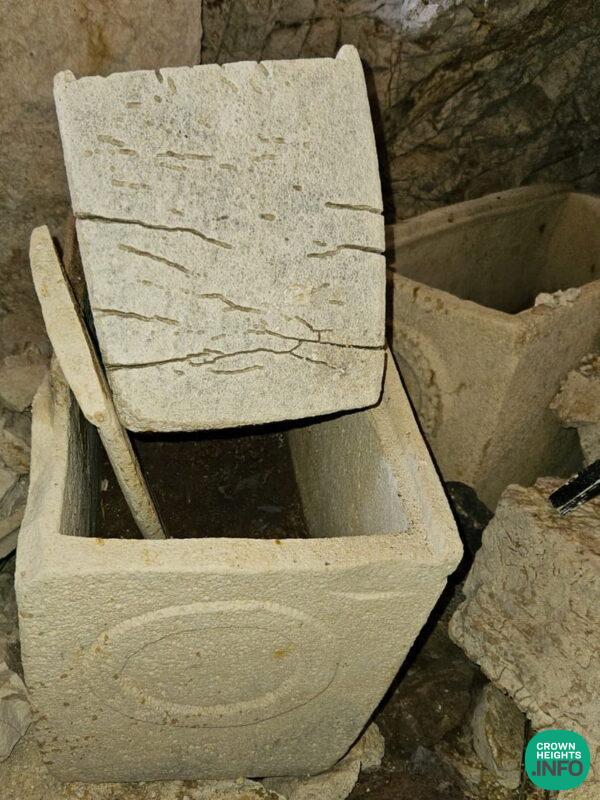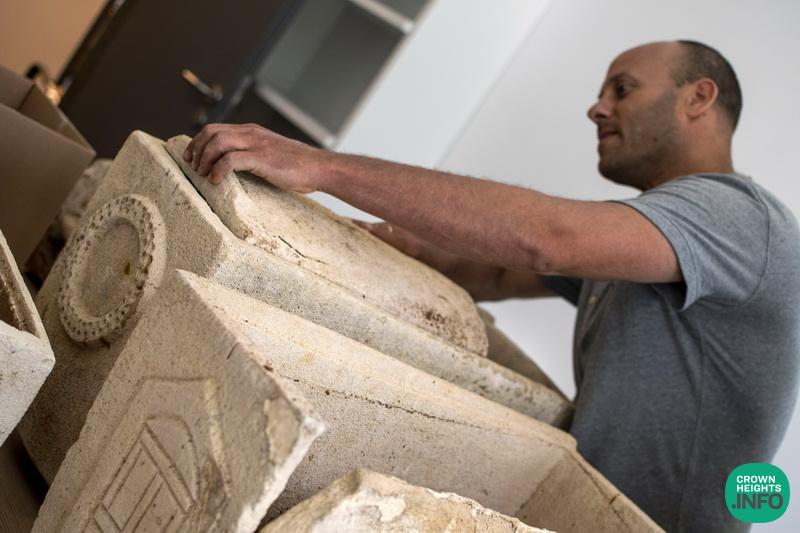
Ancient Jewish Burial Cave Unearthed In Eretz Yisroel
Three 1850-year-old stone ossuaries were retrieved in an operation carried out to prevent antiquity looting near Kafr Kanna in Galilee.
The stone ossuaries (small burial chests) were discovered in a plot near the village of Mashhad, located south of Kafr Kanna in Galilee, in a joint operation by the Kafr Kanna Police and the Israel Antiquities Authority Theft Prevention Unit. The team was shocked to discover that an ancient Roman-period burial cave was almost entirely destroyed in the course of large-scale earthworks.
The inspectors of the Israel Antiquities Authority Theft Prevention Unit then noticed several piles of earth in the plot that seemed to conceal something behind them. To their astonishment, the removal of the earth revealed a second rock-hewn burial cave with nine burial niches, also damaged by the earthworks. Three decorated stone ossuaries and fragments of other ossuaries were found inside the cave. The ossuaries were found empty and not in their original location, raising the immediate suspicion that the cave had recently been looted.
The construction work at the site was stopped, and several people were summoned for questioning at the police station, on the suspicion of damaging antiquities and failing to report the discovery of antiquities. Meanwhile, the Israel Antiquities Authority inspectors documented and collected the ancient finds, to prevent further looting in the cave.
The ossuaries—small rectangular chests carved in soft limestone with flat fitting lids—served for the secondary burial of human bones that were collected after the body tissue had decayed. The custom of secondary burial in stone ossuaries was a Jewish practice carried out in Judea and the Galilee in the Early Roman period, from around the first century BCE. The use of stone ossuaries continued in Galilee throughout the second century CE.
The side of one of the ossuaries was incised with a burial structure, designated a mausoleum in Greek or a “nefesh” in Hebrew. Another coffin was carved with a circular wreath in which holes were drilled—thought by some to symbolize the victory of the deceased over death. The designs, often influenced by Greek culture, are characteristic of the stone ossuaries used by the Jewish population in the Galilee in the Roman period. Similar ossuaries were discovered in the past at the nearby ancient town of Zippori.
According to Amir Ganor, Director of the Theft Prevention Unit at the Israel Antiquities Authority, serious damage to antiquities was carried out at the site, including the destruction of an ancient burial cave, and the looting of another cave: “The original details of the destroyed cave cannot be reconstructed, and almost two-thousand-year-old cultural assets are lost forever. Thanks to the vigilance and determination of the Kafr Kanna Police, and the successful cooperation with the Israel Antiquities Authority, one of the caves was mostly saved.”
According to Eli Escusido, Director of the Israel Antiquities Authority, “In Israel there are about 35,000 archaeological sites, and each and every site is a whole world embellishing information about thousands of years of human history. The destruction of the caves caused irreversible damage. We turn to the public to be vigilant and to assist the Israel Antiquities Authority by reporting any suspicious excavation, quarrying or construction activity in places where there is a risk of damage to antiquities. In this way, good citizens can serve as ‘our eyes in the field.’ Together, we will be able to protect our national treasures and resources – the heritage of the Land of Israel.”
Damaging antiquities is a criminal offense punishable by law, entailing five years imprisonment; there is a legal obligation to report chance finds of antiquities to the Israel Antiquities Authority.
Photography by Yoli Schwartz, Israel Antiquities Authority




















